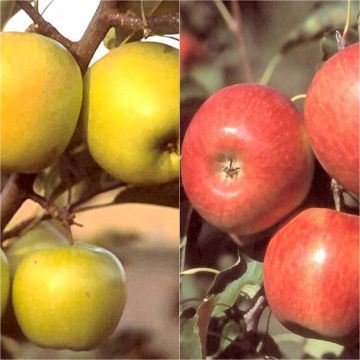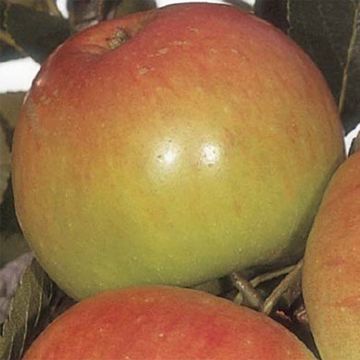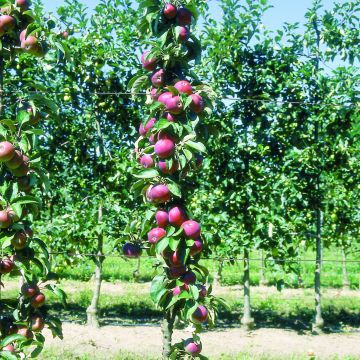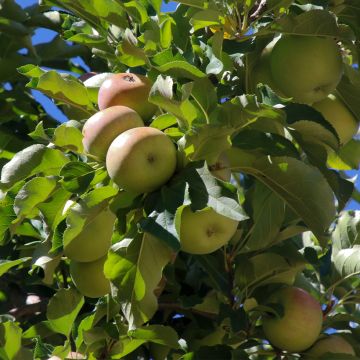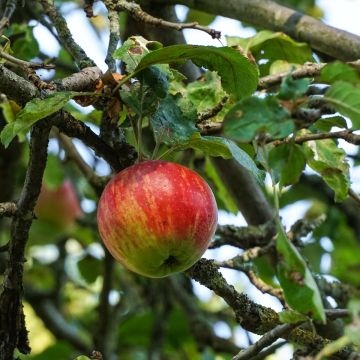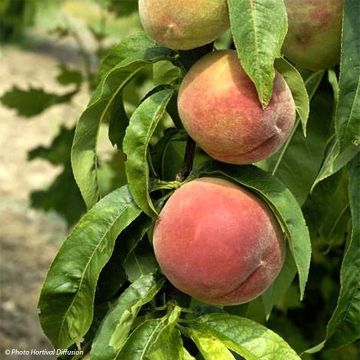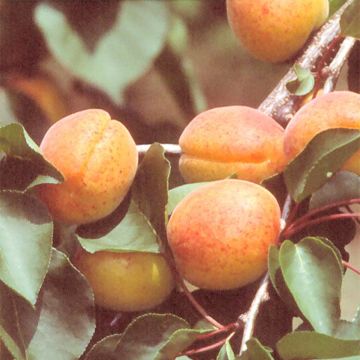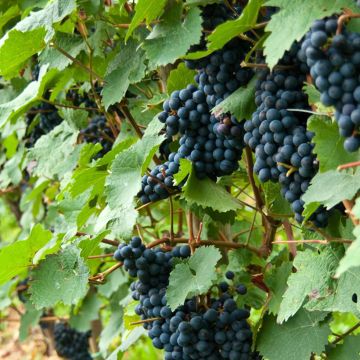

Pommier à cidre Petit Jaune
Cider Apple Tree Petit Jaune - Malus domestica
Malus domestica Petit Jaune
Apple, Orchard apple, Table apple, Cultivated apple
This item cannot be shipped to the selected country
Oversize package delivery charge from €6.90
More information
Schedule delivery date,
and select date in basket
This plant carries a 6 months recovery warranty
More information
We guarantee the quality of our plants for a full growing cycle, and will replace at our expense any plant that fails to recover under normal climatic and planting conditions.
Oversize package: home delivery by special carrier from €6.90 per order..
Express home delivery from €8.90.
Description
Malus domestica 'Petit Jaune' is a highly productive variety of tart apples that bring freshness to cider. It produces a conical-shaped fruit with elongated form, weighing an average of 50 to 90 grams, with golden yellow skin tinged with light red when exposed to sunlight. Its white flesh is crunchy, juicy, pleasantly tart, without bitterness, and aromatic. It reaches ripeness in the second half of October, and the fruits can be consumed immediately after harvesting for cider or juice production, or stored for a few weeks for cooking purposes. It is a self-sterile variety that requires the presence of other apple tree varieties for pollination.
Malus domestica, also known as Malus communis or Malus pumila, is commonly called the Common or Domestic Apple Tree. It belongs to the Rosaceae family. Present in France and Europe since ancient times, it is a fruit tree native to the forests of central Asia. It is highly hardy and is likely the most cultivated fruit tree in Northern Europe. There are approximately 20,000 varieties, including around 10,000 of American origin, 2,000 of English origin, and 2,000 of Chinese origin. Cider has existed since ancient times, known as "Apple Wine." With the invention of the press and the cultivation of apple trees, it began to appear in France from the 12th century. The Normans, the Basques (who called it Sidra), and the Bretons (who called it Chistr) all claim its paternity. The 'Petit Jaune' apple tree originates from the north of Loire-Atlantique and the south of Ille-et-Vilaine. It has been listed as a recommended variety since 1966.
The 'Petit Jaune' cider apple tree is a moderately vigorous fruit tree with a semi-erect habit, spreading crown, and well-branched structure. At maturity, it reaches a height of approximately 5 metres (16 feet) and a width of 4 metres (13 feet), making it suitable for standard high trunk forms. Its foliage consists of large, ovate leaves that are dark green on top and pale green underneath, with deeply toothed edges. The flowering, which occurs in late April to early May, usually avoids frost damage. The flowers are destroyed by temperatures below -2 to -3°C (28.4 to 26.6°F). The apple tree is hardy and can withstand temperatures as low as -20°C (-4°F), making it suitable for cultivation in all regions. Its white blossoms are abundant, remarkably decorative in spring, and highly attractive to bees and other pollinators. Despite its vigour, this variety produces low-quality pollen, making it poorly self-pollinating or capable of pollinating other apple tree varieties. It produces apples with few or no fertile seeds. It is considered self-sterile, which is why the presence of apple trees that bloom at the same time is necessary. Varieties such as 'Kermerrien', 'Douce Coëtligné', 'Douce Moën', 'Fréquin Rouge', 'Rouget de Dol', 'Guillevic', 'C'huero Briz', 'Saint Martin', or any other variety with a late flowering period are suitable for cross-pollination.
The 'Petit Jaune' cider apple tree is a variety that bears fruit quickly, is highly productive, moderately susceptible to powdery mildew and storage diseases, susceptible to apple scab, resistant to fire blight and canker. It is a biennially bearing variety, meaning it produces abundant crops every other year.
This juicy apple with a pleasantly tart flavour is particularly well-suited for cider production or blending with other cider apple varieties to balance flavours. In cooking, it can be used to make jellies, baked apples, or accompany savory dishes made with black pudding, pork, or white meats. Dry ciders (with an alcohol content between 4.5° (40.1°F) and 6.5° (43.7°F)) or sweet ciders (with a maximum alcohol content of 3° (37.4°F)) should be consumed chilled, between 10 and 12°C (50 and 53.6°F). Dry cider pairs well with all kinds of dishes, especially those made with pork, chicken, rabbit, or fish. Sweet cider is wonderful for accompanying desserts, crepes, or for use in cocktails. From cider, a high-quality vinegar can be produced, renowned for its numerous culinary uses (sauces, marinades, chutneys, etc.) and its beneficial effects on health.
Rich in carbohydrates and fructose, apples are invigorating and energizing. They contain vitamins A, B, C, and E, minerals, antioxidants, and fibre, making them a health asset. The fruits can be stored for a few weeks if kept in a cool, well-ventilated place, protected from light, at a temperature of around 8 to 10°C (46.4 to 50°F) or in a cold storage room, sealed off from outside air, at a temperature of 1 to 3°C (33.8 to 37.4°F).
Report an error about the product description
Plant habit
Fruit
Flowering
Foliage
Botanical data
Malus
domestica
Petit Jaune
Rosaceae
Apple, Orchard apple, Table apple, Cultivated apple
Cultivar or hybrid
Other Apple trees
Planting and care
Choose a well-sunny spot for your 'Petit Jaune' cider apple tree. The soil can be slightly chalky or acidic, but not excessively so. Dig a wide planting hole at least 3 times the volume of the root ball. Simultaneously add organic matter (compost, potting soil...) and a base fertilizer such as crushed horn. Do not bury the grafting collar. Stake if necessary. For apple trees planted in isolation and in open areas, it may be interesting to stake them by installing a guy wire system: plant 3 stakes in a triangle 50cm (20in) around the trunk, connect them together with pieces of wood. Protect the bark with a piece of rubber, for example, and attach the stakes to the trunk with metal wires. Water abundantly, even in winter, even if it rains. Fruit trees are ideally planted between October and March, outside the freezing period. Container-grown plants can be planted all year round, except during periods of high heat or frost.
In winter, at the base of the tree and slightly incorporated into the soil surface, you can add a small handful of wood ash, rich in potassium, which will improve fruiting. The apple tree can be subject to various diseases and pests. To limit risks, space the trees sufficiently, install multi-species hedges, birdhouses or insect hotels to attract beneficial insects. In summary: prioritize diversity. The main diseases of the apple tree are scab (brown spots on the leaves), brown rot (wilting of the flowers and rotting of the fruits on the tree) and powdery mildew (white powdery coating on the leaves). For these three cases, preventive action is preferred by spraying a horsetail decoction. As a last resort and in case of severe attacks, you can apply a Bordeaux mixture treatment as a curative action. As for pests, the codling moth (or fruit worm) is a small caterpillar that creates tunnels inside the fruit. To remedy this, it is preferable to act preventively by promoting the installation of tits and bats through the placement of birdhouses. In case of aphid infestation, spray a solution based on black soap.
During the harvest in September, only keep the picked fruits. For good storage, it is desirable to place the apple with its stem downwards, on racks or in crates. Choose a preferably completely dark, dry and cool place, but frost-free.
Planting period
Intended location
Care
This item has not been reviewed yet - be the first to leave a review about it.
Ancient and local varieties
Haven't found what you were looking for?
Hardiness is the lowest winter temperature a plant can endure without suffering serious damage or even dying. However, hardiness is affected by location (a sheltered area, such as a patio), protection (winter cover) and soil type (hardiness is improved by well-drained soil).

Photo Sharing Terms & Conditions
In order to encourage gardeners to interact and share their experiences, Promesse de fleurs offers various media enabling content to be uploaded onto its Site - in particular via the ‘Photo sharing’ module.
The User agrees to refrain from:
- Posting any content that is illegal, prejudicial, insulting, racist, inciteful to hatred, revisionist, contrary to public decency, that infringes on privacy or on the privacy rights of third parties, in particular the publicity rights of persons and goods, intellectual property rights, or the right to privacy.
- Submitting content on behalf of a third party;
- Impersonate the identity of a third party and/or publish any personal information about a third party;
In general, the User undertakes to refrain from any unethical behaviour.
All Content (in particular text, comments, files, images, photos, videos, creative works, etc.), which may be subject to property or intellectual property rights, image or other private rights, shall remain the property of the User, subject to the limited rights granted by the terms of the licence granted by Promesse de fleurs as stated below. Users are at liberty to publish or not to publish such Content on the Site, notably via the ‘Photo Sharing’ facility, and accept that this Content shall be made public and freely accessible, notably on the Internet.
Users further acknowledge, undertake to have ,and guarantee that they hold all necessary rights and permissions to publish such material on the Site, in particular with regard to the legislation in force pertaining to any privacy, property, intellectual property, image, or contractual rights, or rights of any other nature. By publishing such Content on the Site, Users acknowledge accepting full liability as publishers of the Content within the meaning of the law, and grant Promesse de fleurs, free of charge, an inclusive, worldwide licence for the said Content for the entire duration of its publication, including all reproduction, representation, up/downloading, displaying, performing, transmission, and storage rights.
Users also grant permission for their name to be linked to the Content and accept that this link may not always be made available.
By engaging in posting material, Users consent to their Content becoming automatically accessible on the Internet, in particular on other sites and/or blogs and/or web pages of the Promesse de fleurs site, including in particular social pages and the Promesse de fleurs catalogue.
Users may secure the removal of entrusted content free of charge by issuing a simple request via our contact form.
The flowering period indicated on our website applies to countries and regions located in USDA zone 8 (France, the United Kingdom, Ireland, the Netherlands, etc.)
It will vary according to where you live:
- In zones 9 to 10 (Italy, Spain, Greece, etc.), flowering will occur about 2 to 4 weeks earlier.
- In zones 6 to 7 (Germany, Poland, Slovenia, and lower mountainous regions), flowering will be delayed by 2 to 3 weeks.
- In zone 5 (Central Europe, Scandinavia), blooming will be delayed by 3 to 5 weeks.
In temperate climates, pruning of spring-flowering shrubs (forsythia, spireas, etc.) should be done just after flowering.
Pruning of summer-flowering shrubs (Indian Lilac, Perovskia, etc.) can be done in winter or spring.
In cold regions as well as with frost-sensitive plants, avoid pruning too early when severe frosts may still occur.
The planting period indicated on our website applies to countries and regions located in USDA zone 8 (France, United Kingdom, Ireland, Netherlands).
It will vary according to where you live:
- In Mediterranean zones (Marseille, Madrid, Milan, etc.), autumn and winter are the best planting periods.
- In continental zones (Strasbourg, Munich, Vienna, etc.), delay planting by 2 to 3 weeks in spring and bring it forward by 2 to 4 weeks in autumn.
- In mountainous regions (the Alps, Pyrenees, Carpathians, etc.), it is best to plant in late spring (May-June) or late summer (August-September).
The harvesting period indicated on our website applies to countries and regions in USDA zone 8 (France, England, Ireland, the Netherlands).
In colder areas (Scandinavia, Poland, Austria...) fruit and vegetable harvests are likely to be delayed by 3-4 weeks.
In warmer areas (Italy, Spain, Greece, etc.), harvesting will probably take place earlier, depending on weather conditions.
The sowing periods indicated on our website apply to countries and regions within USDA Zone 8 (France, UK, Ireland, Netherlands).
In colder areas (Scandinavia, Poland, Austria...), delay any outdoor sowing by 3-4 weeks, or sow under glass.
In warmer climes (Italy, Spain, Greece, etc.), bring outdoor sowing forward by a few weeks.

































